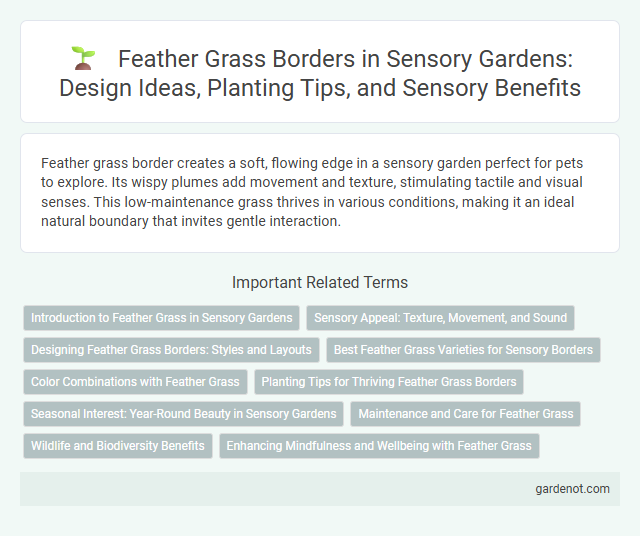Feather grass border creates a soft, flowing edge in a sensory garden perfect for pets to explore. Its wispy plumes add movement and texture, stimulating tactile and visual senses. This low-maintenance grass thrives in various conditions, making it an ideal natural boundary that invites gentle interaction.
Introduction to Feather Grass in Sensory Gardens
Feather grass, known scientifically as Stipa or Nassella, serves as a stunning border plant in sensory gardens due to its fine, wispy texture and movement in the breeze that stimulates tactile and visual senses. Its soft, feather-like plumes create a dynamic sensory experience while enhancing the garden's natural aesthetic and providing habitat for beneficial insects. Growing feather grass is low-maintenance and drought-tolerant, making it ideal for sustainable sensory garden designs focused on multi-sensory engagement.
Sensory Appeal: Texture, Movement, and Sound
Feather grass borders enhance sensory gardens by providing a unique tactile experience with their soft, silky blades that invite gentle touch. The graceful movement of feather grass in the breeze creates dynamic visual interest while producing subtle rustling sounds that deepen the garden's auditory landscape. This combination of texture, motion, and sound stimulates multiple senses, enriching the overall sensory appeal of the garden environment.
Designing Feather Grass Borders: Styles and Layouts
Designing feather grass borders involves selecting varieties like Stipa tenuissima or Festuca glauca for texture and movement, creating a dynamic sensory experience. Arranging feather grass in layered layouts enhances visual interest, with taller grasses at the back and shorter varieties upfront to optimize sightlines and tactile engagement. Incorporating curved or serpentine border shapes adds natural flow, guiding visitors through the sensory garden while emphasizing the grasses' whispering sound in the breeze.
Best Feather Grass Varieties for Sensory Borders
Feather grass varieties such as Stipa tenuissima, Stipa gigantea, and Stipa pennata offer unique textures and gentle movement ideal for sensory garden borders. Stipa tenuissima features fine, wispy foliage that creates a soft, tactile experience, while Stipa gigantea grows taller with striking plumes that enhance visual appeal and rustling sounds. Selecting these best feather grasses enhances sensory engagement by combining visual beauty, texture, and soothing auditory elements in garden design.
Color Combinations with Feather Grass
Feather grass borders create dynamic visual interest through their soft, wispy plumes and graceful movement in the breeze. Pairing feather grass with deep purple salvia or bright yellow coreopsis enhances color contrast, highlighting the grass's silvery-green hues. Combining these plants elevates the sensory experience by adding texture and vibrant seasonal color variations to the garden.
Planting Tips for Thriving Feather Grass Borders
Choose well-drained soil with full sun exposure to establish a thriving feather grass border, as these conditions optimize growth and form. Space plants 18 to 24 inches apart to promote air circulation and prevent overcrowding, enhancing their natural airy texture. Regularly cut back in early spring to remove winter foliage and stimulate fresh, vigorous growth for a lush, elegant border.
Seasonal Interest: Year-Round Beauty in Sensory Gardens
Feather grass borders provide dynamic seasonal interest in sensory gardens with their delicate plumes that shift color from soft green in spring to golden hues in autumn. Their graceful movement in the breeze creates a soothing tactile experience while attracting pollinators such as bees and butterflies throughout the year. This combination of visual texture and ecological benefit ensures feather grass remains a versatile and captivating feature in multi-seasonal sensory garden designs.
Maintenance and Care for Feather Grass
Feather grass borders require well-drained soil and full sun exposure to thrive, with moderate watering to prevent root rot. Regular pruning in early spring removes dead foliage and promotes new growth, while dividing clumps every 3-4 years maintains plant vigor and prevents overcrowding. Applying mulch helps retain moisture and control weeds, ensuring a healthy, attractive sensory garden feature.
Wildlife and Biodiversity Benefits
Feather grass borders provide essential habitat and food sources for pollinators like bees and butterflies, enhancing local biodiversity. Their dense foliage offers shelter and nesting sites for small wildlife such as birds and beneficial insects. These grass borders contribute to ecosystem health by supporting a diverse range of species and promoting a balanced garden environment.
Enhancing Mindfulness and Wellbeing with Feather Grass
Feather grass borders create a soothing sensory experience through their gentle movement and soft texture, promoting mindfulness and reducing stress. The natural rustling sound of feather grass in the breeze encourages mental relaxation and enhances overall wellbeing. Integrating feather grass in sensory gardens supports a calming environment that fosters emotional balance and connection to nature.
Feather grass border Infographic

 gardenot.com
gardenot.com